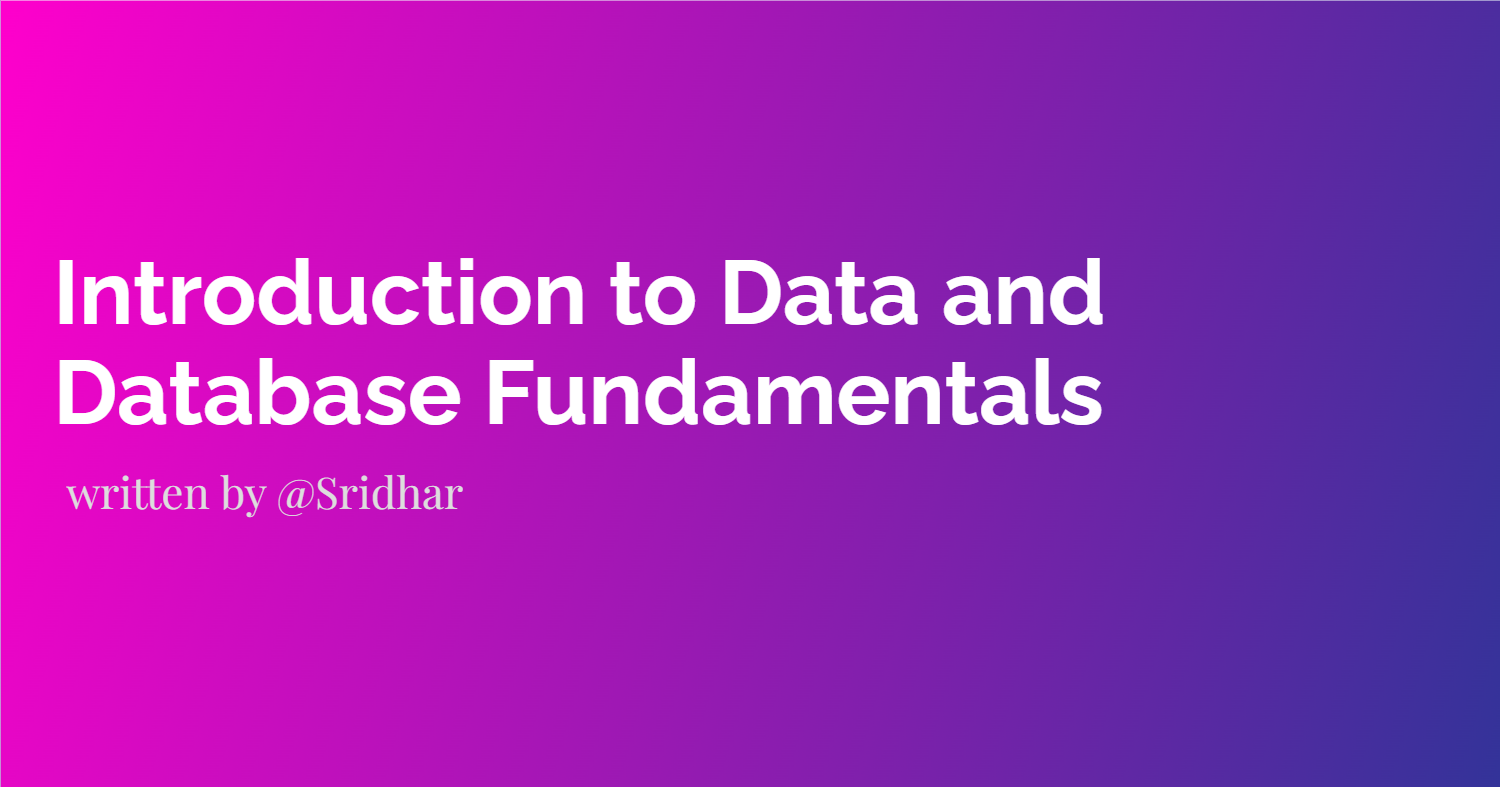Introduction to Data and Database Fundamentals
 Sridhar K
Sridhar K
Introduction to Data
In today's digitalized world, data plays a major role as it is considered to be a company's asset. Data is information about people, places, animals, and things that is stored, retrieved, and used by computers or other digital systems. This information can be in various forms such as:
numbers
text
images
audio
video
Data can be raw, such as unprocessed text, or it can be meaningful, organized data that provides clear context and value.
For instance, consider an age chart. If you just have a list of ages like 23, 34, 45, and 50, it is raw data. Without context, it's hard to derive meaning from it. But if you organize it, associating each age with a person (Arun: 23, Ashwin: 34, Bibin: 45, Fabin: 50), the data becomes meaningful, and we can derive meaning from it.
Types of Data
Data is classified into three types:
Structured data - Collection of organized data.
Semi-structured data - Collection of partially organized data.
Unstructured data. - Collection of unorganized data.
Database
Database is used to store well structured data also known as organized data. It is used to store data permanently and we can retrieve our data without much effort.
Significance of database:
Data Management: Databases offer an effective way to manage, update, and retrieve data. Before databases were introduced, people used the note and pen method to store enormous amounts of data, which was a tedious task. It had numerous disadvantages:
It required several days to manually write the records.
Keeping the records safely was another challenging task.
Retrieving data from the records was a time-consuming process.
Creating a backup record involved a lot of manpower.
However, after databases were introduced, it became easier to store enormous amounts of data, retrieve it for future use, and manipulate the stored data according to our needs.
Constraints of database
These constraints of database maintain the accuracy and consistency of data by preventing duplicate entries and ensuring data relationships are upheld.
Scalability: Databases offer scalability by allowing organizations to handle increasing amounts of data efficiently. As data volumes grow, databases can be expanded or migrated to more robust systems without disrupting operations.
Data Accessibility: With databases, data can be accessed quickly and efficiently using queries, enabling faster decision-making processes and enhancing overall productivity.
Data Consistency: Databases ensure data consistency by providing mechanisms to enforce rules and constraints, thereby reducing the risk of errors and discrepancies in data entries.
Data Integration: Databases facilitate data integration by allowing different systems and applications within an organization to access and share data seamlessly. This integration enhances collaboration and improves data-driven insights.
Data Privacy and Compliance: Databases support data privacy and regulatory compliance by implementing security measures such as encryption, access controls, and audit trails. This ensures that sensitive information is protected and that organizations meet legal requirements.
Business Intelligence (BI) and Analytics: Databases serve as a foundation for business intelligence and analytics initiatives. By storing structured data in a relational format, organizations can perform complex queries, generate reports, and derive valuable insights to support strategic decision-making.
Cloud Integration: Modern databases integrate with cloud platforms, offering benefits such as flexibility, scalability, and reduced operational costs. Cloud-based databases also provide enhanced data availability and disaster recovery capabilities.
Data Warehousing: Databases support data warehousing solutions where historical data from multiple sources is stored and analyzed for business intelligence and reporting purposes. This allows organizations to gain a comprehensive view of their operations and trends over time.
SQL
SQL - Structured Query Language.
Structured Query Language is a query language which is used to communicate with the Relational Database Management Software in order to manage relational databases.
Relational Databases:
It is a type of database where data is stored in a well-organized tabular structure. Here, the data is stored in a table structure to make it easy to understand and retrieve.
Relational Database Management Software
RDBMS uses SQL (Structured Query Language) as the standard language for querying and manipulating data, providing a powerful and standardized way to interact with databases.
RDBMS ensures data integrity through constraints such as:
Primary keys: These uniquely identify each row in a table.
Foreign keys: They establish relationships between tables by referencing primary keys in other tables.
Unique constraints: These enforce uniqueness among values in specified columns.
Tables:
Tables are fundamental structures in RDBMS used to organize and store data.
Each table consists of rows and columns, where columns represent attributes or fields, and rows represent individual records or tuples.
Tables are typically named and defined with a schema that specifies the columns and their data types.
Rows (Tuples):
Rows, also known as tuples, are individual records stored within a table.
Each row contains data related to a specific entity or object, with each column in the row representing a different attribute or characteristic of that entity.
Rows are unique and can be identified by a primary key, which ensures each row has a distinct identifier within the table.
Columns (Attributes):
Columns, also referred to as attributes or fields, define the structure and characteristics of data stored in a table.
Each column has a name and data type (e.g., integer, string, date) that specifies the kind of data it can store.
Columns enforce data integrity by restricting the type of data that can be stored in them and by ensuring consistency across all rows in the table.
Relationships:
Columns in different tables can establish relationships through keys: primary keys and foreign keys.
A primary key uniquely identifies each row in a table and serves as a reference point for establishing relationships with other tables.
Foreign keys are columns in one table that refer to the primary key in another table, enabling data relationships and maintaining data consistency across tables.
DBMS (Database Management System)
A DBMS (Database Management System) is software that lets users create, manage, and control access to databases. It handles tasks like storing, finding, and changing data. Unlike RDBMS (Relational Database Management Systems), a DBMS doesn't require data to be organized in a specific way or enforce relationships between different sets of data.
Conclusion
In this blog, we have explored the fundamentals of data and databases comprehensively. We have defined what data is and why databases are crucial in today's digital landscape as repositories of valuable company assets. Before the advent of databases, we examined the labor-intensive methods used for storing data, highlighting their limitations and disadvantages. Moving forward, we introduced basic concepts of RDBMS and DBMS, emphasizing their roles in organizing data efficiently and enabling secure, structured data management. Understanding these foundational elements equips us with essential knowledge for appreciating the evolution and significance of databases in modern information technology.
Subscribe to my newsletter
Read articles from Sridhar K directly inside your inbox. Subscribe to the newsletter, and don't miss out.
Written by

Sridhar K
Sridhar K
I am a fresher Software developer with a strong foundation in Java, HTML, CSS, and JavaScript. I have experience with various libraries and frameworks, including Spring Boot, Express.js, Node.js, Hibernate, MySQL, and PostgreSQL. I am eager to leverage my technical skills and knowledge to contribute effectively to a dynamic development team. I am committed to continuous learning and am excited to begin my career in a challenging developer role.